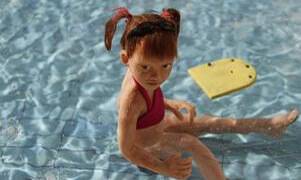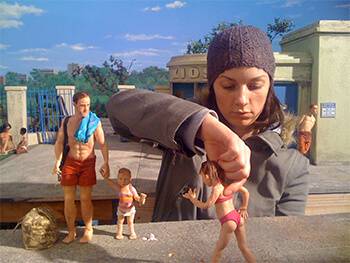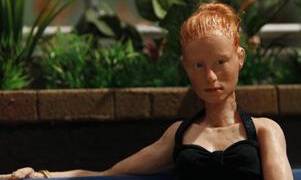Q&A with ‘Grace Under Water’ Director Anthony Lawrence
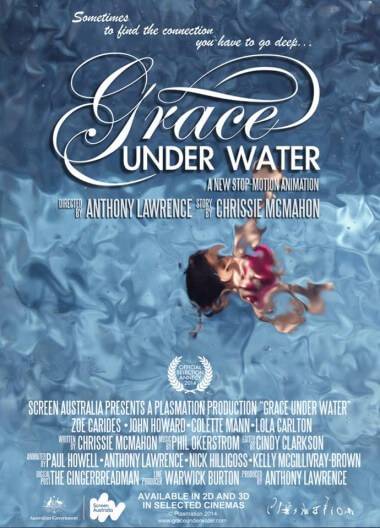 Australian animator Anthony Lawrence’s latest short film Grace Under Water has been making the rounds at festivals including Annecy and Hiroshima, with an upcoming UK screening at this year’s LIAF festival. Making use of uncannily detailed stop-motion puppetry and 3D stereoscopy, the film’s understated story is of Lou, whose frustrations toward the non-relationship with her new stepdaughter come to a head during a day out at a local swimming pool. With a 25 year career in the industry working on shorts, workshops and the Australian TV series Plasmo, Grace Under Water marks Lawrence’s second short film collaboration with writer Chrissie McMahon, following 2001’s Looking For Horses.
Australian animator Anthony Lawrence’s latest short film Grace Under Water has been making the rounds at festivals including Annecy and Hiroshima, with an upcoming UK screening at this year’s LIAF festival. Making use of uncannily detailed stop-motion puppetry and 3D stereoscopy, the film’s understated story is of Lou, whose frustrations toward the non-relationship with her new stepdaughter come to a head during a day out at a local swimming pool. With a 25 year career in the industry working on shorts, workshops and the Australian TV series Plasmo, Grace Under Water marks Lawrence’s second short film collaboration with writer Chrissie McMahon, following 2001’s Looking For Horses.
Some of your earlier work has taken on the more surrealist and fantastical potential stop-motion animation is capable of. How did you find the transition to more true-to-life visualisation when it came to your work with Chrissie McMahon?
The more realistic you try to go, the more difficult building the puppets and sets becomes as the audience is well tuned to what looks “right” and what doesn’t whereas in a fantasy/sci fi or surrealistic style, you have more leeway in the construction as there are no absolutes in how something fantastic should, or shouldn’t look. In that regard, the sculpts and model making for Grace Under Water was more challenging. Most people who build sets and sculpt puppets for stop motion are used to creating things more caricatured and disproportionate. It took some time to find the people who could put that aside and go realistic. I spent a lot of time with sculptors looking at head proportions, swapping different sized heads onto bodies and seeing how that affected our perception of the character. As Grace Under Water is not a comedy, I really wanted to avoid the oversized, cartoony heads at all costs.
How did the two of you come to know of each other and eventually collaborate?
It was around 2000 and we both worked at The Distance Education Centre, as teachers in a correspondence school. Through word of mouth I heard that Chrissie enjoyed writing short stories. It was good timing as one of the funding bodies and SBS at that time were looking to fund a short animation compilation series with the theme of Australian families, and I asked Chrissie if she had any stories which would fit the brief. Chrissie did have a thirty page story called Looking For Horses but Finding Goats which was condensed down to six pages and became Looking For Horses. Happily this was accepted for the series and we were able to make it. I had to leave the job at the Distance Education Centre to make it however, but Chrissie continued on there. In 2009 I asked Chrissie if she had another script we could try to get funded as an animation, and again she had one called Grace Under Water. The first time we applied it was knocked back, but the next year after some changes, we got the funding.
While Grace Under Water‘s setting allows for a fair amount of ingenious practical effects, the humanity of the story it tells is not one that would necessarily depend on animation . Ultimately what motivated the use of stop-motion for the film?
I believe that detailed, “realistic” styles of stop motion creates a hyper realism which creates an opportunity to draw an audience in more to the story. By hyper realism I mean that everything you see on screen has been deliberately constructed, placed and lit, and nothing that is not important has been included. So you get the pure essence of the meaning with no added distractions. Whereas in live action, the scenes would be shot in locations where there is a lot of “stuff” not necessarily absolutely important for the story or mood. The exception would be if there were specially designed and constructed sets.
https://www.youtube.com/watch?v=1AYWVrA9V2U
What main lessons would you say the two of you took from your first film collaboration Looking For Horses?
Looking For Horses gave us the confidence that we could distill the essence from a short story of thirty pages, to a six or seven page animation script, which was what was required in Grace Under Water. There was always give and take with regards to bantering ideas back and forth, working out what we could keep, what we could toss, and also what can be done using film techniques such as editing to engage the audience. I loved Chrissie’s use of language and she came to appreciate my input into the story by what she saw I could do with editing and the timing of words and images.
The water surface rippling was done with a thin layer of clear hair gel, sandwiched between a clear acrylic plastic base and a thin sheet of clear acetate. By dimpling the acetate very couple of frames it gave the water the movement. This was random but as the audience hopefully has their gaze set on the puppet, the water motion is peripheral, so didn’t have to be scientifically accurate, obeying physics laws of wave movement. The advantage of the physical approach to water surface was that it gave realistic light reflections and also realistic distortion of what was beneath. In instances where there was a rippling water foreground which made it hard to reach over to get to the puppets, this foreground water was animated first, then the layer pulled away, so the animator could get in closer to the puppet without stretching. The animated water was then composited back in later in post.
Splashes were achieved using random cuttings of thin acetate plastic film that had been blasted with a hot air gun to shrink and distort and “firm up” the shape. The heat also melted the acetate slightly creating placing soft edges, a surface bubbling and organic contours. Then there would be a collection of these splash plastics that could be used accordingly. Wrapping plastic is sometimes used but that has little rigidity and may sag if the splash is high.
The underwater bubble trail seen a couple of times in the film was created using a material I stumbled upon in Singapore. I like to call it Material X and although I am not secretive about stop motion techniques, I am hesitant to reveal what this material is given that in doing so I will be depriving present and future animators the satisfaction of discovering it for themselves, and just the same as conjuring, the illusion is less impressive when the trick becomes common knowledge.
Why did you decide to shoot the film stereoscopically?
I’ve always been interested in stereo photography, going back to childhood when I would gaze into a bakelite Viewmaster and try to understand why it was that the images seemed more real than a normal photo. When Stopmotion Pro software included an option for taking left and right images, utilising an automated X-Y axis rig around 2011, it seemed the perfect opportunity to use 3D as a way to create further realism to the film. When I look at stereo images, I just think, “Why wouldn’t you shoot 3D?” It allows the mind to take in and see so much more spatially, I don’t see it as a gimmick anymore than I see colour or sound as a gimmick. One post production editor I spoke too expressed the view that 3D didn’t add anything to the story so why use it? Well, often a story doesn’t need colour either, but still the film is likely to be shot in colour. Some stories don’t even need to be made into films either, yet films are made of them. Shooting stereoscopically for me was a learning experience also, however it did mean that many in-camera effects such as glass paintings, tracking shots, go-motion that i like to use, had to be abandoned. The most difficult process for the stereo version was having the post house do rig removals and digital touch ups the same on each left and right frame, on a low budget.
Were there any unexpected challenges in the production or preparation for the shoot as a result of this approach?
The X-Y Rig was from a UK company, and getting the driver to work it with my computer took some sorting out. One really needed to be a programmer almost to muddle through the installation process! One of stop motion photographic rules is to do with absolute camera stability, and here we are trusting a machine that moves the camera with every frame taken! And unfortunately during the animation process, the machine did fail to return to its exact marks each time, for reasons unknown. So that delayed the shoot for a week while that problem was sorted out.
The design of the puppets themselves is interesting in that they have more fidelity to actual human proportions than a lot of stop-motion puppetry. Assuming that design plays a large role in the ease of animation itself, how did you find this style to work with?
We were working in one sixth scale, so the puppet heads ended up being only 35 mm in height. The seam lines which mold makers try to get very thin, would be proportionately thicker in this small scale. Unfortunately a smaller scale puppet does not translate to smaller scale seam lines!
The eyes were only 3mm in diameter so animating them was tricky, especially since I don’t use pinholes in the front of the eyeballs, which I think is hideously ugly and distracting. Placing armature wires into the small heads also was very tricky, almost requiring a microscope to position. I had to develop some new techniques for keeping the two halts of the silicone moods together, and for holding wires in place while the silicone to embed them in the facial area set. Some facial expressions demanded replacement heads, so we needed to be able to easily remove heads from the puppet body. To get alternative expressions without having to ask the scuptor to resculpt the head from scratch, I made a silicone mold of first head, then cast it in Monster clay, which pours easily when melted, and from the set Monster Clay cast, the expression could be rescuplted, then a new mood made of that version.
Although the movement itself is quite subdued, there’s something quite striking and effective about way faces appear in the film; Even though the eyes are clearly fabricated (as opposed to, say, a live-action compositing approach in films such as Madame Tutli-Putli) there’s a lot of life behind them. Were there any special considerations when achieving this effect?
For close ups I had always intended to have scaled up heads made. However time and budget would not allow this so I had to make do with using the 1/6 scale heads for any close ups. One of the more successful close ups I feel is where Young Lou has been dragged up out of the backyard pool and getting a rough rub down by the step father. Peanut oil was gently brushed onto the eyes to create a glisten as though she were holding back tears. Also I moved the eyes slightly to give a sense of the characters internal turmoil at that moment. I had to use the tip of a sharp scalpel to get leverage on the tiny eyeball, so it could be moved in its silicone socket.
I’ve been looking back at some of your work with the character Plasmo, which was developed for television following a series of short films and received a strong critical response in Australia. How did you find this experience, and would you do more TV/series work should the opportunity arise?
Plasmo has been by far my most satisfying and rewarding experience in animation, achieved on a shoestring budget with a small team. Over the years I have enjoyed getting feedback from people who remember Plasmo from their youth and tell me of the effect it had on them. One person was inspired to study to become an astrobiologist! In developing Plasmo I created much more story content than could be fitted into 13 by 5 minutes and I have enough material for a new series, which I would love to do given the opportunity. Last time that opportunity was only created after obtaining presales, distribution guarantees and convincing funding bodies to back it. Getting something like this up in Australia has always been very very hard, taking years of work. It actually took longer to get the backing, than it did to physically create the while series. I guess that is normal though in this economic climate. Very few Australian films make their money back, and short animation series do not make that much money back for investors from television sales. I did try to find Merchandising companies for Plasmo, but as it was new at the time they weren’t prepared to take a risk. Plasmo kind of remains a bit underground, remembered fondly by nineties kids, now grown adults.
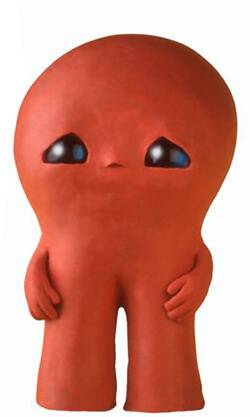
Anthony Lawrence’s Plasmo
There’s quite a lot of strong stop-motion which has come out of Australia in recent years (eg. Adam Elliot, Michael Cusack, Isabel Peppard). How do you find the medium and/or animation in general is regarded over there? Is there much by way of government support for the arts?
Melbourne and Sydney have had a strong stop motion culture in the past, particularly between the mid eighties to mid nineties. During this time there were a few very successful animation companies making TV ads, who intermittently supplied work and training for teams of artists in the field. With the rise of computer animation, and dwindling of TV advertising budgets, stop motion has been squeezed back. Companies have shrunk or closed up shop. There are some tertiary animation courses that provide a source of graduates each year however. Unfortunately animation is not widespread in Australian Primary and secondary schools yet despite its being so accessible now with new technology and software. Getting funding for stop motion is always a struggle with limited government funding available, and the private sector won’t jump in unless you can prove to them its a money making venture, which unfortunately to date, no stop motion in Australia that I know about has actually turned a profit. Although its not necessarily motivated by profit, it just makes it harder too find the money required too make world class stop motion unless there is some chance of a return on the investment. That probably why so many stop motion animators have to fund their own work and animate in tiny backyard sheds or garages.
What kind of project would you like to work on next (or are there any already in motion)?
I really enjoy teaching approaches to stop motion animation, and often run workshops for people with disabilities.
Grace Under Water will screen at the London International Animation Festival on Sunday October 26th in the 9pm Being Human screening. For more information on the film visit graceunderwater.com


